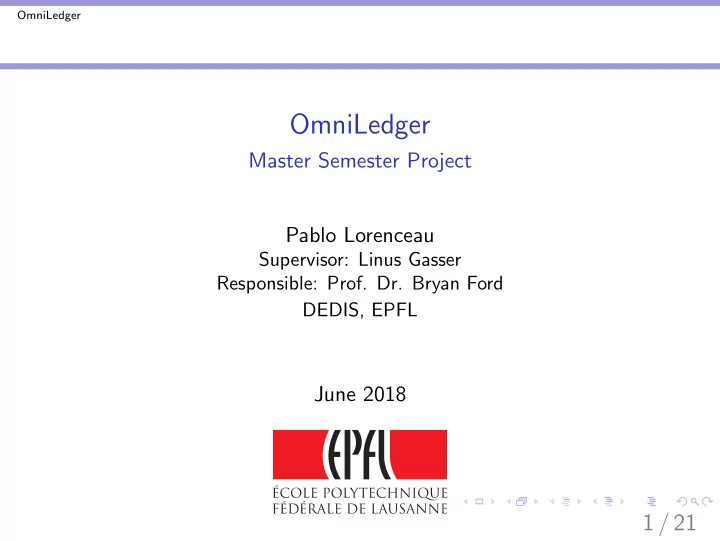

OmniLedger OmniLedger Master Semester Project Pablo Lorenceau Supervisor: Linus Gasser Responsible: Prof. Dr. Bryan Ford DEDIS, EPFL June 2018 1 / 21
OmniLedger Overview Table of Contents Overview Background Implementation 2 / 21
OmniLedger Overview Overview OmniLedger is a highly scalable blockchain which uses ◮ a non-probabilistic consensus protocol, ◮ an identity-blockchain to decouple identity establishment from transaction processing, ◮ sharding to improve throughput, ◮ an atomic commit protocol for cross-shard transactions ◮ and assigns nodes to shards in a scure manner. It scales to performances comparable to VISA. Our Goal: Implemenent it! 3 / 21
OmniLedger Overview Figure : OmniLedger: Colors indicate shards. ( Kokoris-Kogias et al., IEEE S&P 18 ). 4 / 21
OmniLedger Overview Overview of the Implementation OmniLedger is a system built on to of the skipchain which ◮ stores state in a Merkle-tree like data structure (collection), ◮ allows clients to modify state by sending transactions, ◮ and has different callback functions (contracts) per type of state, called when processing requests. Clients can request a cryptographic proof about the state of the collection. 5 / 21
OmniLedger Background Table of Contents Overview Background Implementation 6 / 21
OmniLedger Background Skipchain Skipchains are blockchains which ◮ have more than one backward link, ◮ have forward links pointing to future block ◮ and allow clients to traverse the chain efficiently. Skipchains are also useful for offline verification. 7 / 21
OmniLedger Background Figure : The skipchain: Backward and forward links span multiple hops, allowing clients to efficiently traverse the chain ( Nikitin et al., USENIX Security 17 ). 8 / 21
OmniLedger Background ByzCoinX Omniledger use ByzCoinX for consensus: ◮ No forks occur. ◮ The root node (leader) proposes a block to the other nodes (validators). ◮ A block is accepted ⇐ 2 3 of the validators sign it. ⇒ Note:ByzCoinX allows for only f byzantine nodes out of 3 f + 1 total nodes. More: Next presentation. 9 / 21
OmniLedger Background Figure : ByzCoinX: The root proposes a block to the rest of the nodes which have to collectively sign it. ( Kokoris-Kogias et al., USENIX Security 16 ). 10 / 21
OmniLedger Implementation Table of Contents Overview Background Implementation 11 / 21
OmniLedger Implementation Structures ◮ Collections ◮ Darcs ◮ Transactions ◮ Contracts 12 / 21
OmniLedger Implementation Collections Collections are ◮ based on Merkle trees, ◮ operate as a key-value store ◮ and can issue proofs about their state, verifiable by any client knowing the Merkle-root of the collection. More: Next presentation. 13 / 21
OmniLedger Implementation Figure : Collections: The keys are ordered in a deterministc fash- ion which allows to prove the absence or presence of a given key-value pair. ( github.com/dedis/student 18 omniledger/tree/master/omniledger/collection ). 14 / 21
OmniLedger Implementation Darcs Darcs ◮ map actions to signature requirements, ◮ are stored in the collection itself ◮ and can be evolved by a user with the corresponding permission. Example: update : Jeff ∧ ( Linus ∨ Kelong ) 15 / 21
OmniLedger Implementation Figure : The structure of a our implementation. 16 / 21
OmniLedger Implementation Transactions Transactions contain a list of instructions. An instruction: ◮ can be one of Spawn, Invoke, delete, ◮ contains a key for the collection, ◮ a key via the authenticating Darc ◮ and can effect multiple state changes. 17 / 21
OmniLedger Implementation Contracts Contracts ◮ are called when a transaction is checked for validity: At block creation time by the leader and when voting with the validators. ◮ are stored in the collection itself ◮ and can be evolved by a user with the corresponding permission. 18 / 21
OmniLedger Implementation Figure : The structure of a skipblock. 19 / 21
OmniLedger Implementation My Contributions ◮ Initial skeleton ◮ Apply transactions tentatively ◮ Dummy contracts ◮ Sort transactions 20 / 21
OmniLedger Implementation Conclusion and Future Work Omniledger is a flexible system, but has some drawbacks (for now) ◮ Leader is assumed to be correct. ◮ No dynamic deployment of contracts. ◮ Only leader queues transactions for now. Which are then applied to the collection. 21 / 21
Recommend
More recommend